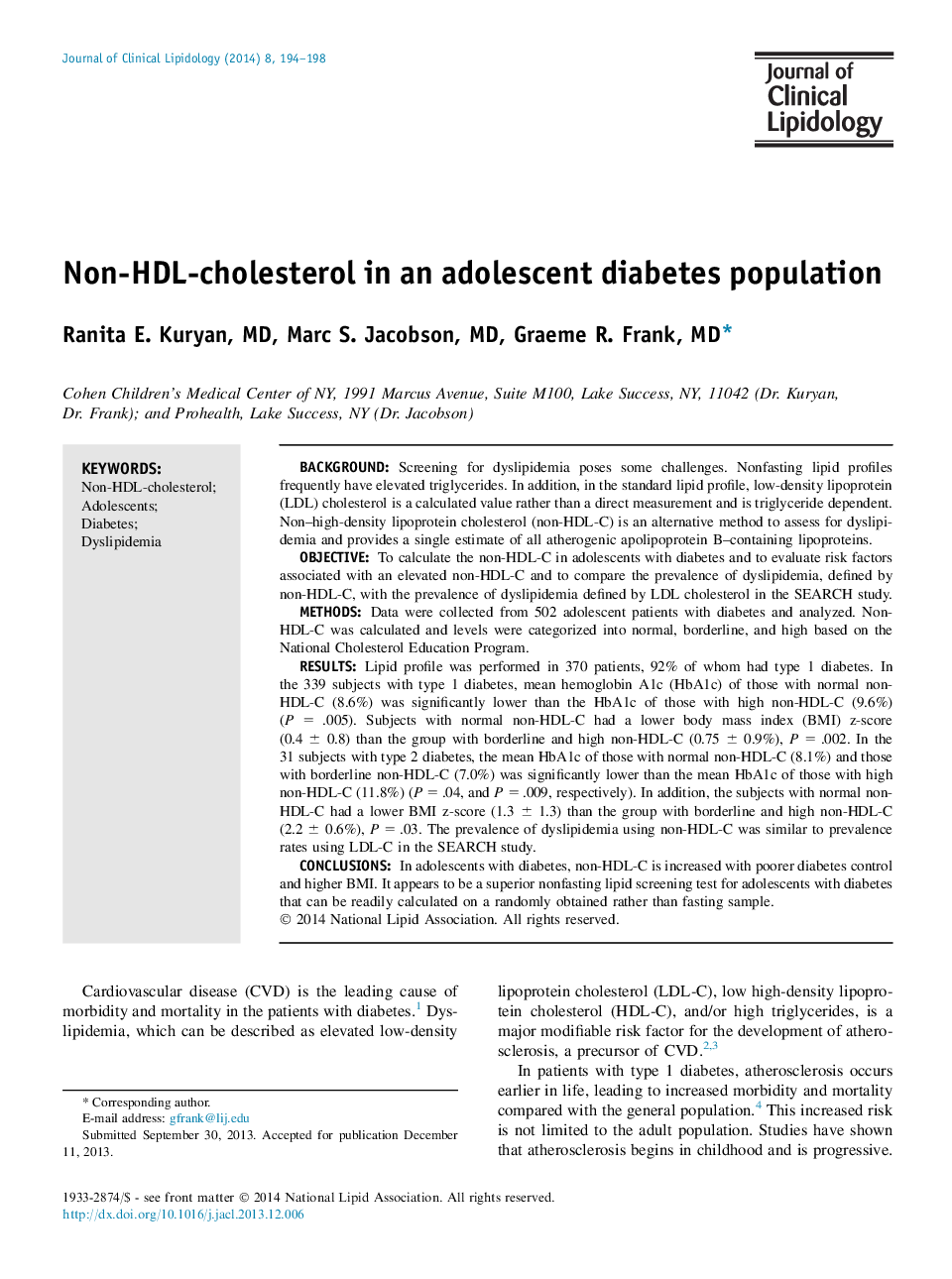| کد مقاله | کد نشریه | سال انتشار | مقاله انگلیسی | نسخه تمام متن |
|---|---|---|---|---|
| 2966272 | 1178800 | 2014 | 5 صفحه PDF | دانلود رایگان |

► Screening for dyslipidemia in patients with diabetes is challenging
► Non-HDL cholesterol is a method to assess dyslipidemia in the nonfasting state
► Poor diabetes control and high BMI z-scores are associated with higher non-HDL-C
► Non-HDL-C appears to be an adequate screening tool for dyslipidemia in diabetes
BackgroundScreening for dyslipidemia poses some challenges. Nonfasting lipid profiles frequently have elevated triglycerides. In addition, in the standard lipid profile, low-density lipoprotein (LDL) cholesterol is a calculated value rather than a direct measurement and is triglyceride dependent. Non–high-density lipoprotein cholesterol (non-HDL-C) is an alternative method to assess for dyslipidemia and provides a single estimate of all atherogenic apolipoprotein B–containing lipoproteins.ObjectiveTo calculate the non-HDL-C in adolescents with diabetes and to evaluate risk factors associated with an elevated non-HDL-C and to compare the prevalence of dyslipidemia, defined by non-HDL-C, with the prevalence of dyslipidemia defined by LDL cholesterol in the SEARCH study.MethodsData were collected from 502 adolescent patients with diabetes and analyzed. Non-HDL-C was calculated and levels were categorized into normal, borderline, and high based on the National Cholesterol Education Program.ResultsLipid profile was performed in 370 patients, 92% of whom had type 1 diabetes. In the 339 subjects with type 1 diabetes, mean hemoglobin A1c (HbA1c) of those with normal non-HDL-C (8.6%) was significantly lower than the HbA1c of those with high non-HDL-C (9.6%) (P = .005). Subjects with normal non-HDL-C had a lower body mass index (BMI) z-score (0.4 ± 0.8) than the group with borderline and high non-HDL-C (0.75 ± 0.9%), P = .002. In the 31 subjects with type 2 diabetes, the mean HbA1c of those with normal non-HDL-C (8.1%) and those with borderline non-HDL-C (7.0%) was significantly lower than the mean HbA1c of those with high non-HDL-C (11.8%) (P = .04, and P = .009, respectively). In addition, the subjects with normal non-HDL-C had a lower BMI z-score (1.3 ± 1.3) than the group with borderline and high non-HDL-C (2.2 ± 0.6%), P = .03. The prevalence of dyslipidemia using non-HDL-C was similar to prevalence rates using LDL-C in the SEARCH study.ConclusionsIn adolescents with diabetes, non-HDL-C is increased with poorer diabetes control and higher BMI. It appears to be a superior nonfasting lipid screening test for adolescents with diabetes that can be readily calculated on a randomly obtained rather than fasting sample.
Journal: Journal of Clinical Lipidology - Volume 8, Issue 2, March–April 2014, Pages 194–198